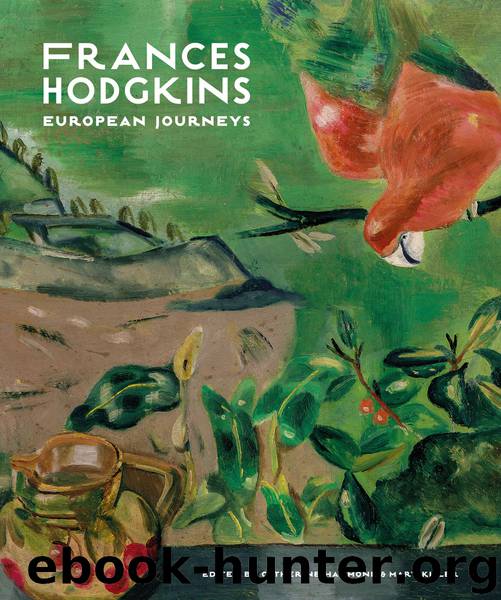Frances Hodgkins by Catherine Hammond

Author:Catherine Hammond
Language: eng
Format: epub
Publisher: Auckland University Press
Published: 2019-02-18T16:00:00+00:00
FIGURE 7.2
Cover of AC: documentos de actividad contemporánea, no. 21, 1935
At the time Hodgkins visited, Ibiza found itself between two worlds – its economy had traditionally depended on agriculture and the exploitation of its salt flats, but in the 1930s tourism offered new possibilities for development. The Spanish press celebrated the fact that many painters were immortalising the island’s tiny villages with their iconic architecture and dramatic landscapes (fig. 7.2), while simultaneously criticising the extravagant attire of the more hedonistic among them. The budding tourist industry consisted of a dedicated bus offering tours of some of the island’s signature sights, which ran alongside the local buses that carried supplies around the island and allowed both locals and visitors to move from village to village. In 1935, Spanish journalist Irene Polo characterised Ibiza as a peaceful Garden of Eden, praising the locals for their kindness, simplicity and sense of hospitality.3 A year later, a group of tourists from Barcelona described Sa Penya, the humble fishermen’s neighbourhood beneath the old walled citadel where Hodgkins had found inspiration for some of her drawings, watercolours and oil paintings, as a poor yet exotic fantasy.
By the end of 1932 there already existed a thriving local Catalan art scene, at the centre of which was the Ebusus Society, founded in 1927. The painter and photographer Narcís Puget Viñas served as its patron,4 encouraged by the Valencian artist Joaquín Sorolla when the latter visited the island in 1919. The first art gallery in Ibiza, run by German painter Maria Ferst, opened in the 1930s. The sudden influx of international artists and intellectuals, though, appears to have gone largely unnoticed by many of the strongly independent locals, a sideshow to their daily lives. These ‘outsiders’, as Ibizans would most likely have called them, merely elicited a mixture of sympathy and suspicion.
The Balearics and the Costa Brava (wild coast) stretching up to the French border were beginning to take on a more political tone as Jewish refugees fleeing from German national socialism moved south looking for safe havens. Among them were the German philosopher Walter Benjamin, who made two trips to the island in the years 1932 and 1933 (the same period Hodgkins was there), and the Austrian Dadaist and architect Raoul Hausmann, who stayed several years longer.
Ibiza and Tossa de Mar, on the Costa Brava about 150 kilometres north of Barcelona, were suggested as excellent venues for subject matter by Karl Hagedorn and his wife, who had stayed there, and Hodgkins may also have chosen Ibiza because the island was a favoured haunt of Maurice Garnier, whose company she had enjoyed while staying in St Jeannet in 1930. She found accommodation in Passeig de Vara de Rey, the handsome tree-lined avenue that serves as the main square in the township of Ibiza, at Hotel Balear, a small establishment with just ten rooms, overlooking the main square.
When Hodgkins arrived, eight of the rooms at Hotel Balear were taken by émigrés, only one of whom spoke English. There were so
Download
This site does not store any files on its server. We only index and link to content provided by other sites. Please contact the content providers to delete copyright contents if any and email us, we'll remove relevant links or contents immediately.
The Secret History by Donna Tartt(16618)
Red Sparrow by Jason Matthews(4661)
Harry Potter 02 & The Chamber Of Secrets (Illustrated) by J.K. Rowling(3291)
In a Sunburned Country by Bill Bryson(2945)
Figure Drawing for Artists by Steve Huston(2795)
The Daily Stoic by Holiday Ryan & Hanselman Stephen(2706)
Drawing Cutting Edge Anatomy by Christopher Hart(2676)
The Roots of Romanticism (Second Edition) by Berlin Isaiah Hardy Henry Gray John(2565)
Japanese Design by Patricia J. Graham(2553)
Make Comics Like the Pros by Greg Pak(2422)
Stacked Decks by The Rotenberg Collection(2270)
Harry Potter and the Deathly Hallows (7) by J.K. Rowling(2214)
On Photography by Susan Sontag(2128)
Draw-A-Saurus by James Silvani(2103)
Tattoo Art by Doralba Picerno(2083)
Foreign Devils on the Silk Road: The Search for the Lost Treasures of Central Asia by Peter Hopkirk(2054)
The Traveler's Gift by Andy Andrews(2010)
Churchill by Paul Johnson(2008)
Drawing and Painting Birds by Tim Wootton(1997)
